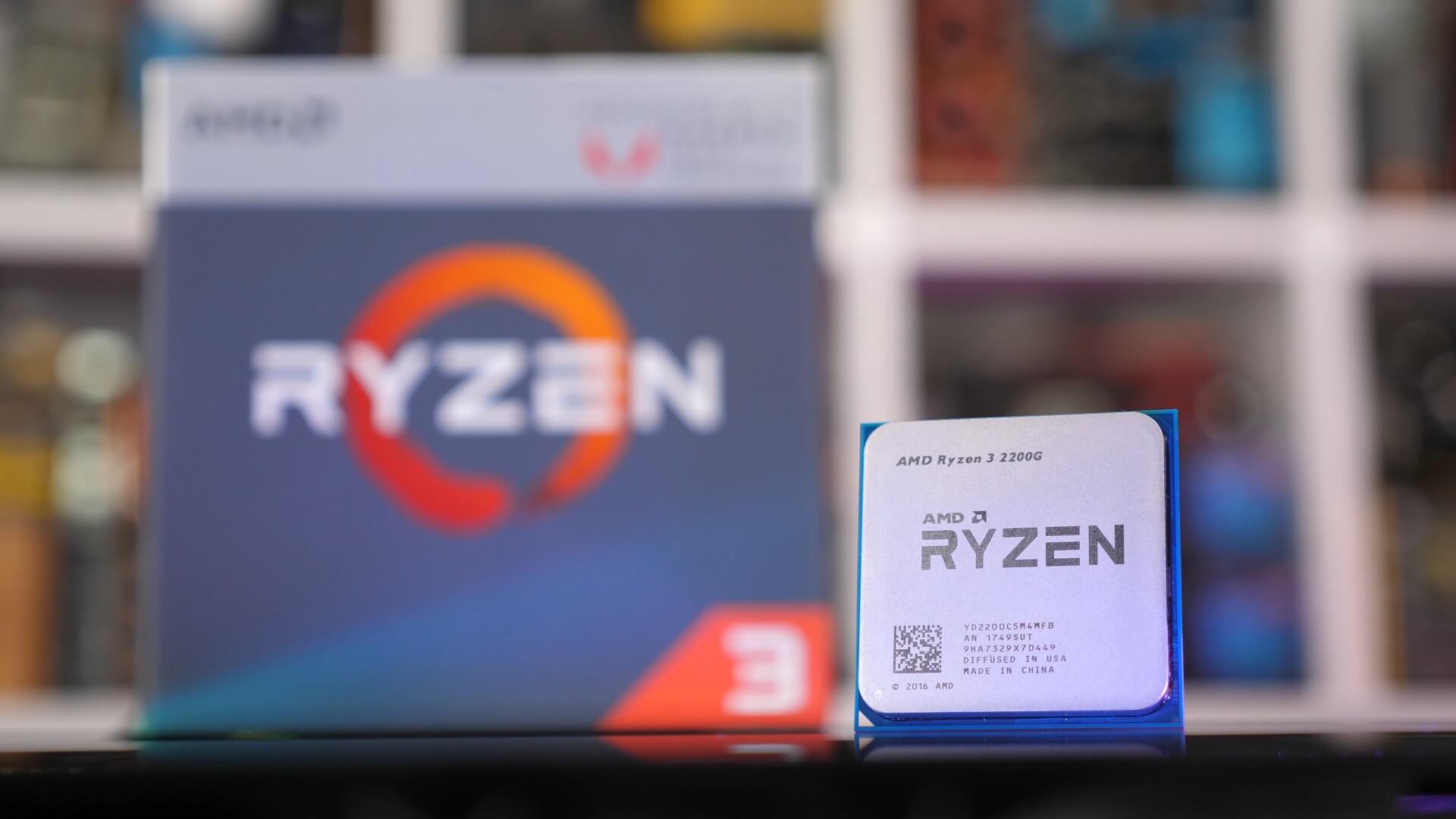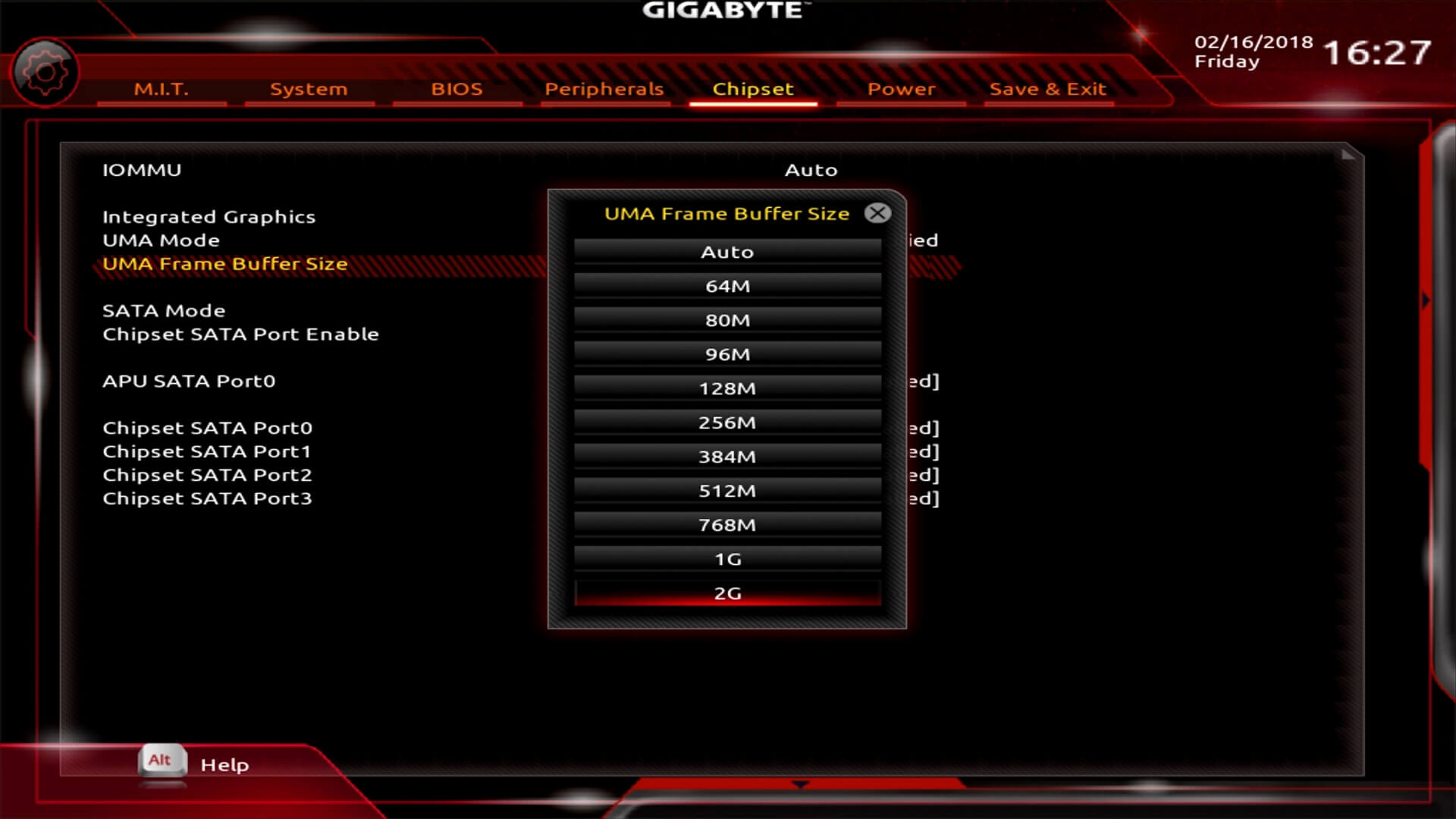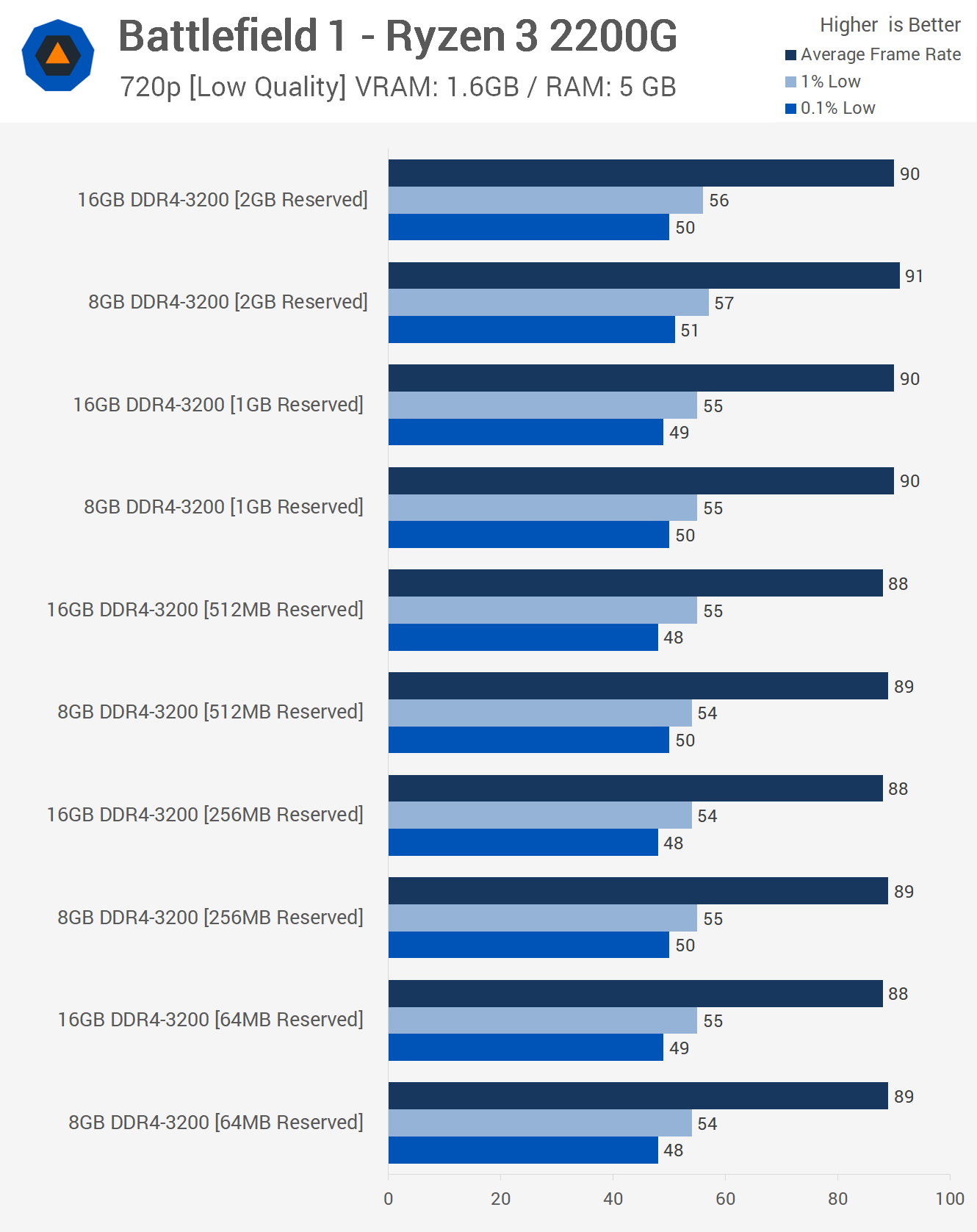AMD Raven Ridge 8GB vs. 16GB Reserved Memory Benchmark & Explanation - gogginsmakeles
We recently took our front view AMD's Predate Ridge desktop APUs afterward a grueling four day grind of benchmarking the Ryzen 5 2400G and Ryzen 3 2200G. Although some chips were important-looking on that initial run, thither's still wads of data that we'd like to cover, including deeper overclocking tests.
However, since bill the limited review, a couple of questions have popped up and the one that I've probably seen the most revolves around the Vega GPU's memory apportioning.
Dissimilar a typical separate graphics wit, most incorporated solutions don't have their own dedicated memory. For representative, a Vega 64 has 8GB of dedicated memory where it can depot data and then access it quickly when it needs to. Because this is a high-end nontextual matter card, not only it has a large 8GB buffer but the bus information technology uses to access this memory is also quite an fast. HBM2 provides a 2048-bit inaccurate bus that with the memory clocked at 1.25GHz allows for a bandwidth of 483GB/s.

Advance down the food for thought concatenation, like at the bottom, you'll get graphics cards such as the RX 550. Because the reckon performance for this card is around nine times lower, it doesn't deman such a massive bandwidth OR an 8GB computer storage buffer either. In fact, the RX 550 could only take advantage of half that capacity and in nowadays's games the card whole caboodle also with a 2GB buffer. Regardless of capacity though, information technology uses memory clocked at 1.75GHz and with a 128-piece large bus can be FRS data at 112GB/s.
Variable data in and out of system storage is importantly slower than VRAM.
Indeed a typical RX 550 has a 2GB retention buffer that can transmutation data at a peak rate of 112GB/s. Now if a game requires 3GB of VRAM merely you only wealthy person 2GB, both game assets overflow into system memory (RAM). I moon-splashed this in a bit more detail somewhat recently that investigated how much RAM gamers want.
Shifting data in and retired of system memory is significantly slower than VRAM. The Raven Ridge Genus Apus for example are limited to a remembering bandwidth of or so 35GB/s for organization computer storage when using DDR4-3200. So in the event of the RX 550, it has a bandwidth of 112GB/s when accessing data locally using the VRAM, but when accessing data from system memory it's circumscribed to 16GB/s (PCIe 3.0 x16 limit), which is to say that information technology takes at to the lowest degree seven times longer to process the same data.
If your estimator runs out of system memory, game assets are then moved to the local memory device -- meaning your hard drive, or hopefully SSD -- and depending connected how fast that device is you bet intemperately it's hit with data, you are very believable to see a noticeable dip in framerate at this point as the bandwidth would be small to around 500MB/s with a SATA SSD.
Retention all that information in mind, note again that the integrated graphics chip inside the Raven Rooftree APU has no topical memory. We're stressing this because some coeducational GPUs equivalent the Vega M graphics in upcoming Intel Kaby Lake-G processors do have their personal dedicated memory and this greatly enhances performance, but it's also much more costly.
Since AMD's Pig Ridge APUs are budget solutions, it wasn't practical to include HBM2 memory. So with no dedicated VRAM, it relies exclusively on system memory that is restricted to bandwidth of around 35GB/s when victimization DDR4-3200.
Of course of action, bandwidth is just part of the outlet Hera, memory capacity also plays a key role. A system with a dishonorable model Radeon RX 550 and 8GB of DDR4 memory efficaciously has 10 GB of total computer storage. But when exploitation the integrated Vega 8 Oregon 11 graphics inside the Raven Ridgeline APUs, you have 8GB of memory that needs to constitute shared between the CPU and GPU.
Generally, Windows does a good speculate of managing retentivity and prioritizing applications for best results, but at least some allot of your system store will live allocated to the integrated graphics. Raven Rooftree APUs use a method called Unified Storage Architecture or UMA for short.
Almost current AM4 motherboards let you set the storage size somewhere between 64MB and 2GB. Contingent what size up you select, this testament determine the maximum amount of money of organization memory that is allocated solely to the Vega graphics. Once allocated, it bottom only be used as graphics memory and will no more be accessible to the operating system or applications.

Now this is where I'm seeing a morsel of confusion and misinformation. Some people are claiming that for primo results reviewers should test with the frame buffer store set to the maximum size and correct now that's 2GB. However, this isn't necessarily true and as we're about to ascertain, most of you WHO have built or are planning to build a Raven Ridge scheme will desire to Doctor of Osteopathy the complete opposite.
You are far better off selecting the absolute minimum amount of scheme memory that you can, because as I said, once you apportion a portion of your system memory to the art processor, that's complete it can represent exploited for.
If you go overboard here, then while running tasks that don't require much video storage in Windows you will have a significant chunk of idle memory that throne't constitute used. If you were to select a 2GB buffer on a arrangement that has 8GB of DDR4 memory, that would entail you'd only wealthy person 6GB of organisation memory available.
I wouldn't suggest choosing a 2GB buffer even if you welcome maximum carrying into action in games. As I discussed earlier, when gaming, once the graphics memory or VRAM fills up, secret plan assets are then pixilated into organisation memory board in any event and the Raven Ridgeline APUs using system of rules retentiveness exclusively, so regardless of whether you allocate 64MB or 2GB, IT doesn't really issue.
If a game calls for 2GB of video memory but you've only allocated 64MB, usage still spills over into the shared RAM and because information technology's every the same memory the bandwidth remains the same and then does the performance. Windows manages this all right indeed by allocating 2GB you're just restricting the in operation system's ability to manage system memory optimally.
When hard to make sense of why AMD was offering a 1GB and 2GB frame buffer, I initially thought that peradventur aside reserving a careful amount of memory, say 2GB, this would ensure maximum gaming performance equally the operating system wouldn't have to shuffle things around, especially when using 8GB of RAM versus 16GB or more.
However, after testing various configurations I found this had little to nobelium impact on gaming performance, certainly nothing you'd notice when gaming. Using both 8GB and 16GB of dual-channel DDR4-3200 memory with the literal same timings, I ground none real performance difference between reserving 64MB or 2GB of system memory for example. I proven half a dozen modern titles that all call for around 2-3GB of VRAM at 1080p using low to intermediate quality settings.


Rather than look at the half a dozen titles I've tested, completely of which show the exact same matter, I'm honourable going to set ahead the Battleground 1 results at 720p and 1080p, along with some additive examination with Tube: Last Luminescent. As you give notice see with BF1, all the results are within the margin of error for a leash run average and we're not just talking about the average frame rate but also frame time performance arsenic well.
The 2GB configuration was up to 9% faster when comparison the 1% low results, but if we accept that at that place's a +/- 1fps margin of error present the deviation could be every bit small as 3%. In any type it wasn't possible to spot this difference when actually playing the game and Field 1 was one of the few games to show any kind of measurable difference.

I accepted a some reports that Metro: Last Light byword a massive performance uplift when going from 512MB to 2GB and although I stopped testing with this title about three eld agone I thought it would be singular if true so I decided to check it out. This game uses very little memory and here we saw no difference in performance when comparing the average frame rate at 720p and 1080p, the same was true for the frame time results likewise.
Given what we discussed previously in front acquiring into the results, this genuinely shouldn't surprise anyone. Disregarding of whether the Vega GPU is accessing information via the allocated memory or not, if it's still victimisation system memory and is small to the same bandwidth, just about 35GB/s in this case.

In fact, we can depend at this a little more closely. Using the AIDA64 GPGPU benchmark tool we potty measure read and write performance between the CPU and GPU, in effect mensuration the performance the GPU could proceed data in and out of its own twist memory into the organisation memory. This is too called Twist-to-Host Bandwidth.

More importantly, for what I wish to show, we can also look at memory copy performance. This test measures the performance of the GPU memory by copying data from its own device memory to other lay out inside the same device memory. So in the eccentric of the RX 550 that would be the onboard GDDR5 memory, but in the showcase of the Raven Ridge APUs, it's the scheme memory.
Here we can attend that with 64MB of RAM allocated, the Vega 8 GPU in the 2200G has a throughput of 33.4GB/s when copying data from within the system memory, and that's pretty much in line with the 35GB/s the CPU cores have when accessing the DDR4-3200 memory.
If we increase the apportionment sized to 2GB, this has no impact on bandwidth and instead based on an average of three runs we byword a slender decrease but that is within the margin of error. Given how long this test takes it's sound to accept we are transferring well over 2GB of information so it's not just benchmarking within the allocated buffer. Then if we look at the RX 550 which has a theoretical peak bandwidth of 112GB/s we see in this test information technology was good for 88GB/s. For equivalence, I benched a Vega 56 and this framework hit 321GB/s with a theoretical visor bandwidth of 410GB/s.

So all the evidence suggests that setting the iGPU allocated memory board buffer beyond 64MB is purposeless and on systems with noncomprehensive RAM, even a bit mindless. That same, patc I've tested quite a a couple of games and applications forthwith, I haven't test them all and of course I won't be able to as in that respect simply aren't plenty hours in the day.
The only reason I behind consider wherefore you might want to gain the reserved memory buffer is for games that need to detect a certain amount of VRAM before they will load. We've seen games with improved in safeguards that won't allow for you to load them without meeting a minimum hardware spec. IT's annoying as the game developer isn't saving anyone from anything, certainly no real harm, instead they're evenhanded inconveniencing gamers that probably have accepted hardware but are wait on a driver update to improve detection.
I expect that AMD will forever deliver drivers to solve these kinds of issues for new games if and when they arise, but we power see situations where in the meantime gamers buns increase the allocation to meet the VRAM requirements, allowing them to load into the spirited. So short of potential compatibility issues, I privy't take to be whatever reasons why you'd neediness to give more than 64MB of memory to the GPU, but maybe you guys have some ideas.

Please too annotation that 64MB power be an extreme example, mayhap err on the safe side and set it to 512MB. Or you could just move out with 64MB and wait boulder clay you hunt into an issue and if you do please let us know almost information technology. At that point, you would only have to bring up the scheme, increase the allocation and then load back into Windows.
Since most APU users will comprise using two 4GB memory modules for an 8GB capacity, especially those buying the incredibly good value Ryzen 3 2200G for $100, those users will deficiency to save As a good deal memory as possible and telling them to lop slay 1-2GB for the Vega GPU seems like-minded really bad advice based on my findings.
Circling back to the time when I was speaking about trying to spend a penny sense of why AMD was offering up a 2GB frame buff, in that location's even been talk that AMD is pushing board partners to offer a 4GB choice. Only wherefore, AMD? Why give your customers the ability to degrade their experience on your impressive Raven Ridge Apus?
Healthy, the reason is simple, marketing. AMD has to sport the game of Book of Numbers. Saying 2GB or up to 2GB of graphics memory sounds improved than 64MB. That said, AMD doesn't appear at this stage to comprise advertising Lope Felix de Vega Carpio 8 and Vega 11's memory specification. Maybe this will start to pop in the lead once the company nears the launch of 4GB parceling.
As we were putting final touches on this feature and our testing, we got in touch with AMD and after liberal them our results they're having their engineers superficial into it. AMD tells U.S. they are testing a wide vagabon of games and we have also tested on the far side what you see here.
For the to the highest degree part we saw very pocket-size difference. At the most, averages variegate by up to 5% in some instances but it's mostly 3% or inferior. You may amplification an extra 2-3 Federal Protective Service using 2GB opposing to 64MB in the best case scenario, just Raven Ridge is way more sympathetic on the low end if I can have just about all 8GB of my system memory when using applications in Windows, rather than only 6GB.
Indeed for users with 8GB Oregon to a lesser extent RAM you're break polish off with the 64 – 512MB options. Upright apply a small overclock to gain ground a few extra frames when you need them.
Source: https://www.techspot.com/article/1578-amd-raven-ridge-reserved-memory-explainer/
Posted by: gogginsmakeles.blogspot.com


0 Response to "AMD Raven Ridge 8GB vs. 16GB Reserved Memory Benchmark & Explanation - gogginsmakeles"
Post a Comment